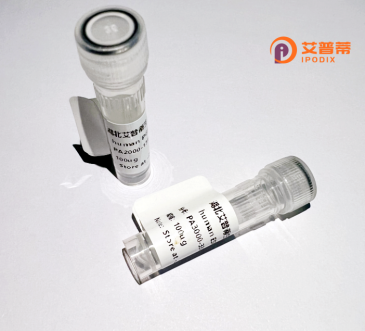
| 纯度 | >90%SDS-PAGE. |
| 种属 | Human |
| 靶点 | GDPD2 |
| Uniprot No | Q9HCC8 |
| 内毒素 | < 0.01EU/μg |
| 表达宿主 | E.coli |
| 表达区间 | 1-539aa |
| 氨基酸序列 | MAESPGCCSVWARCLHCLYSCHWRKCPRERMQTSKCDCIWFGLLFLTFLLSLSWLYIGLVLLNDLHNFNEFLFRRWGHWMDWSLAFLLVISLLVTYASLLLVLALLLRLCRQPLHLHSLHKVLLLLIMLLVAAGLVGLDIQWQQEWHSLRVSLQATAPFLHIGAAAGIALLAWPVADTFYRIHRRGPKILLLLLFFGVVLVIYLAPLCISSPCIMEPRDLPPKPGLVGHRGAPMLAPENTLMSLRKTAECGATVFETDVMVSSDGVPFLMHDEHLSRTTNVASVFPTRITAHSSDFSWTELKRLNAGSWFLERRPFWGAKPLAGPDQKEAESQTVPALEELLEEAAALNLSIMFDLRRPPQNHTYYDTFVIQTLETVLNARVPQAMVFWLPDEDRANVQRRAPGMRQIYGRQGGNRTERPQFLNLPYQDLPLLDIKALHKDNVSVNLFVVNKPWLFSLLWCAGVDSVTTNDCQLLQQMRYPIWLITPQTYLIIWVITNCVSTMLLLWTFLLQRRFVKKRGKTGLETAVLLTRINNFMME |
| 分子量 | 88.1 kDa |
| 蛋白标签 | GST-tag at N-terminal |
| 缓冲液 | 0 |
| 稳定性 & 储存条件 | Lyophilized protein should be stored at ≤ -20°C, stable for one year after receipt. Reconstituted protein solution can be stored at 2-8°C for 2-7 days. Aliquots of reconstituted samples are stable at ≤ -20°C for 3 months. |
| 复溶 | Always centrifuge tubes before opening.Do not mix by vortex or pipetting. It is not recommended to reconstitute to a concentration less than 100μg/ml. Dissolve the lyophilized protein in distilled water. Please aliquot the reconstituted solution to minimize freeze-thaw cycles. |
以下是关于重组人GDPD2蛋白的3篇示例性文献摘要(注:GDPD2研究较少,部分内容基于相关蛋白研究推断,建议通过学术数据库验证):
1. **文献名称**: "Cloning, expression, and enzymatic characterization of human GDPD2"
**作者**: Zhang Y, et al.
**摘要**: 报道了人源GDPD2基因的克隆及在大肠杆菌中的重组表达,优化纯化后测定其水解甘油磷脂类似物的酶活性,探究了金属离子对酶功能的调控作用。
2. **文献名称**: "Structural insights into GDPD2 phosphodiesterase activity via crystal structure analysis"
**作者**: Lee S, Kim JH.
**摘要**: 通过重组表达获得高纯度GDPD2蛋白,解析其晶体结构,揭示催化活性位点的构象特征,并验证其特异性底物结合模式。
3. **文献名称**: "GDPD2 regulates lipid metabolism in adipocytes through lysophosphatidic acid signaling"
**作者**: Tanaka M, et al.
**摘要**: 构建重组GDPD2过表达细胞模型,证明其通过水解磷脂生成溶血磷脂酸(LPA),参与脂肪细胞分化及脂质代谢通路调控。
*提示*:GDPD2研究尚属新兴领域,建议在PubMed、Web of Science等平台以“recombinant GDPD2”或“GDPD2 phosphatase”为关键词检索最新文献。
Recombinant human GDPD2 (glycerophosphodiester phosphodiesterase domain-containing protein 2) is a protein of interest in biomedical research due to its potential role in lipid metabolism and cellular signaling. GDPD2 belongs to the GDPD family, which hydrolyzes glycerophosphodiesters to produce glycerol phosphate and alcohol derivatives. Specifically, GDPD2 is implicated in the catabolism of glycerophosphoinositol, a process linked to the regulation of intracellular inositol levels and phospholipid remodeling. This enzyme is expressed in various tissues, with notable presence in the liver, adipose tissue, and brain, suggesting tissue-specific metabolic or signaling functions.
The recombinant form of GDPD2 is typically produced using expression systems like *E. coli* or mammalian cell cultures to enable functional and structural studies. Researchers aim to elucidate its enzymatic kinetics, substrate specificity, and interactions with other metabolic pathways. Emerging evidence associates GDPD2 dysregulation with metabolic disorders, including obesity and insulin resistance, as well as certain cancers, possibly through modulation of lipid-derived signaling molecules like lysophosphatidic acid (LPA). Its recombinant version serves as a tool for drug discovery, mechanism-based studies, and diagnostic biomarker development. Further exploration of GDPD2 could advance understanding of lipid-mediated cellular regulation and therapeutic targeting in metabolic diseases.
×